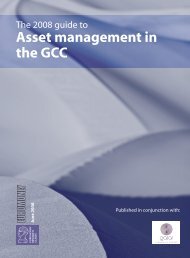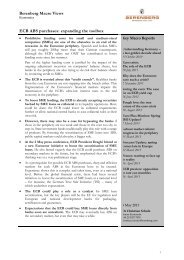Download guide (PDF) - Euromoney
Download guide (PDF) - Euromoney
Download guide (PDF) - Euromoney
Create successful ePaper yourself
Turn your PDF publications into a flip-book with our unique Google optimized e-Paper software.
8<br />
The 2012 <strong>guide</strong> to<br />
GLOBAL RISK TRENDS<br />
Eurozone bank stability<br />
remains key focus<br />
Far from stabilizing, the risks associated with the eurozone<br />
debt crisis are still rising and infecting other parts of the world,<br />
as banking sector problems deepen and extend their reach<br />
Bank stability has become an<br />
increasingly dominant factor<br />
for counterparties and deposit<br />
holders seeking safety. Each of<br />
ECR’s country experts is asked to quantify<br />
bank stability risk, by awarding a score<br />
ranging from 10, typifying a perfectly<br />
functioning system where all possible<br />
exposures are comfortably covered, to<br />
zero, where a systemic breakdown in the<br />
banking system has occurred.<br />
Interestingly, bank stability and<br />
government debt appear to go hand in<br />
hand. High scores are correlated with low<br />
levels of debt and vice versa, with some<br />
exceptions. Finland, Luxembourg and<br />
Slovakia, the three countries with the<br />
highest bank stability scores, have low<br />
levels of debt (below the EU’s 60% of GDP<br />
limit). Greece, Ireland, Portugal and Italy,<br />
those eurozone sovereigns with the lowest<br />
bank stability scores, all have triple-digit<br />
public debt ratios.<br />
The correlation is similar for bank<br />
stability and another of ECR’s surveyed<br />
indicators, government finances. A<br />
higher bank stability score is generally<br />
linked to a higher score for government<br />
finances, while the opposite is also true.<br />
This link between sovereign debt and<br />
bank stability is explained in an article<br />
by Michael Davies and Tim Ng, ‘The rise<br />
Eurostat<br />
180<br />
160<br />
140<br />
120<br />
100<br />
80<br />
60<br />
40<br />
20<br />
0<br />
General Government Debt, % of GDP (y-axis)<br />
vs ECR Bank Stability Scores (x-axis)<br />
Source: <strong>Euromoney</strong> Country Risk; Eurostat<br />
0 1 2 3 4 5 6 7 8 9 10

















